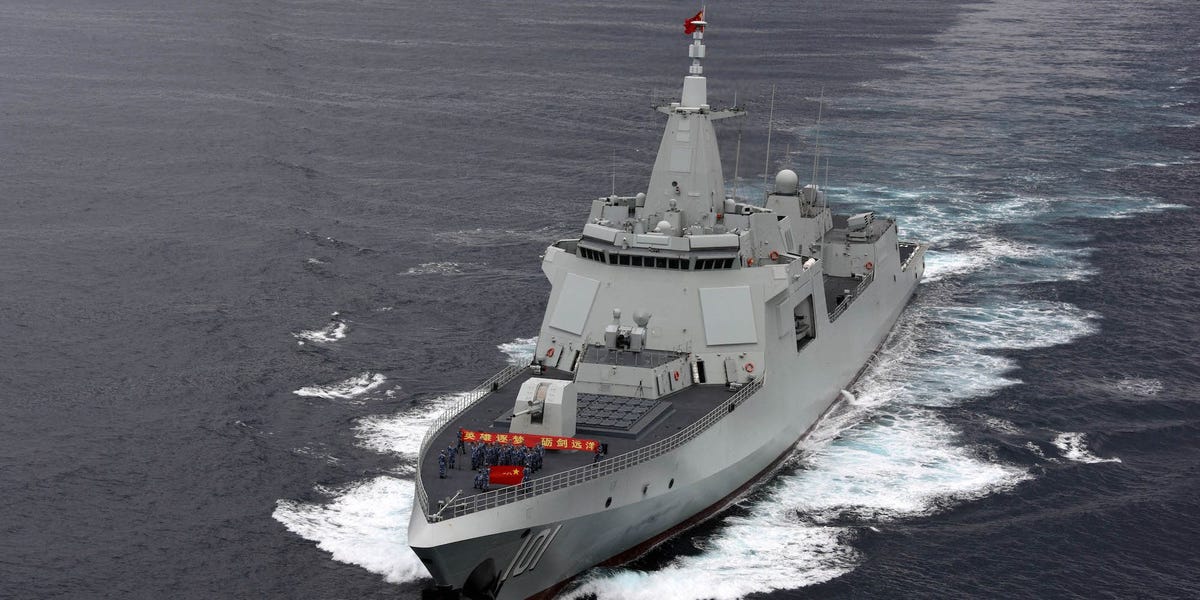In an unusual decision, China disclosed a wargame scenario where a US fleet sank one of its top warships. In this simulated exercise, the Chinese vessel succeeded in temporarily disrupting incoming US missile systems. Analysts in naval strategy suggest that the nature of this Chinese wargame is highly atypical, raising concerns about potential disinformation.
Why would China seemingly take pride in a simulation that portrays a loss of one of its most formidable warships to US missile strikes? It could hint that China has gained insights into the operational secrets of what the US considers its key anti-ship missile system. Alternatively, some Western experts propose that this might be a strategic move to shake the United States’ confidence in its military capabilities.
The revelation of the wargame was reported in early January by the South China Morning Post, referencing a paper published in November in the Chinese journal Command Control & Simulation. Conducted by the North China Institute of Computing Technology, the simulation depicted a Chinese carrier battle group operating in the South China Sea near the Pratas Islands, which are controlled by Taiwan but claimed by China.
Without clear reasons, the Chinese fleet was targeted by a US carrier strike group aiming to take down a Type 055 destroyer that was providing escort to the Chinese carrier. The Type 055, weighing 13,000 tons and classified by the Pentagon as a cruiser, is a highly advanced ship equipped with 112 launchers capable of firing various kinds of missiles, including anti-ship, anti-aircraft, and land-attack variants.
According to the Morning Post, “The US military initiated a large-scale strike against the Chinese fleet, launching a coordinated attack with ten AGM-158C Long Range Anti-Ship Missiles (LRASMs) from various platforms.” This missile, developed by Lockheed Martin, is known for its stealth characteristics and has an estimated operational range of at least 200 miles. It employs multiple guidance systems, including GPS, onboard radar, and thermal sensors for targeting, even if satellite signals are compromised.
In the Chinese simulation, the US destroyers launched the LRASMs, which initially ascended to a high altitude before descending close to the ocean’s surface to evade radar detection. As these missiles neared their target, the report claimed that their radars failed successively due to electronic warfare tactics employed by the People’s Liberation Army (PLA), resulting in the loss of GPS positioning signals.
At this critical point in the simulation, the missiles shifted to thermal imaging to continue their approach, rapidly rising to identify their target just before descending to a lower altitude to strike the Chinese destroyer successfully. Chinese researchers asserted that they gleaned insights about the LRASM through a combination of open-source intelligence and extensive research.
However, even the Morning Post—which is owned by e-commerce powerhouse Alibaba with close ties to the Chinese government—conceded that they could not verify the accuracy of how the missile was depicted in the wargame using publicly available information.
Interestingly, the inclusion of the LRASM in Chinese military exercises does not surprise experts, as its capabilities would be crucial for any US strategy aimed at defending Taiwan from a potential Chinese offensive. Yet, Western analysts were taken aback by China’s confidence in its understanding of the missile’s guidance systems, enough to replicate them within a simulation.
Moreover, it’s remarkable that the Chinese government permitted its media and defense publications to circulate results from a wargame that typically remains classified. When nations learn about an enemy’s weapons through espionage or intelligence efforts, they usually hesitate to reveal such knowledge to avoid disclosing vulnerabilities.
British naval experts suggest another interpretation: China might be engaging in psychological operations aimed at the United States. “Framed as a ‘humble brag’ despite the loss of a PLAN destroyer, this article blatantly showcases a specific confidence from China in the ongoing arms race where both countries, as leading technological powers, are now engaged,” stated Edward Black and Sidharth Kaushal in an analysis for the Royal United Services Institute in the UK.
Black and Kaushal observe several notable elements within the Chinese wargame. For instance, the simulation presupposes that the Chinese destroyer successfully jammed the LRASM’s passive radar, which typically detects electronic signatures from enemy vessels without emitting its own signals. This would reflect China’s advancements in countermeasures to disrupt passive radar systems.
They highlight that the PLA’s claimed success here would have significant implications for both the survivability of stealth missiles and US naval strategies concerning emissions control and passive detection systems.
Additionally, the game showcases a scenario where the LRASM’s GPS was potentially interfered with, denoting a level of Chinese confidence in its capabilities to counter American anti-jamming technology. There’s also an evident gap in the simulation’s narrative: the Type 055 destroyer relied solely on electronic warfare methods against the LRASMs, even though it is equipped with various robust defensive missiles and systems.
To engage LRASMs effectively, the destroyer would have needed to detect the incoming missiles first, thus allowing the operational capability to deploy its countermeasures. Each LRASM carries a warhead weighing 1,000 pounds, capable of inflicting substantial damage to any naval vessel, making reliance on electronic warfare alone at such short range (approximately six miles) an odd strategic choice.
Even in cases of jamming, the LRASM can still home in on thermal signatures, like a ship’s exhaust, using infrared guidance. It’s improbable for a warship to depend on electronic warfare exclusively against missiles so near, as any failure in their anti-jam mechanisms would leave no time for launching interceptor missiles or even confirm if a gun could effectively track and fire at multiple incoming targets.
Black and Kaushal propose a more sinister motive for China publicizing this wargame: it may serve as misinformation intended to destabilize American confidence in the LRASM. Many critical features of the missile remain classified. If China models the LRASM in its simulations, could this indicate that they have clandestinely acquired sensitive information about its capabilities?
However, the British analysts are skeptical, concluding, “If the PLA were genuinely confident in its ability to access sensitive data, it would have compelling reasons to maintain this information privately to achieve strategic surprise, rather than alerting the US to potential compromises of critical systems.”













